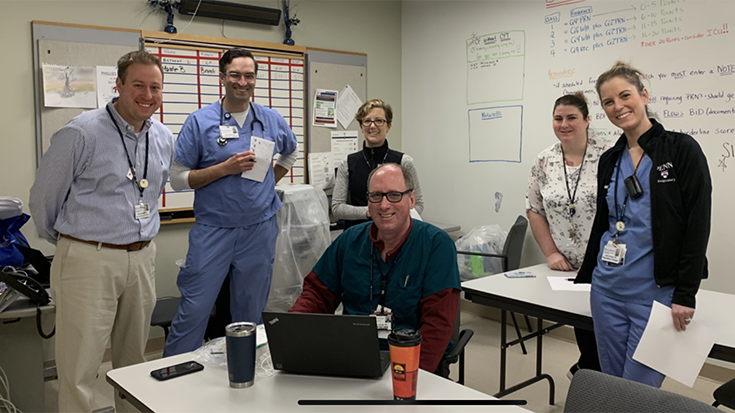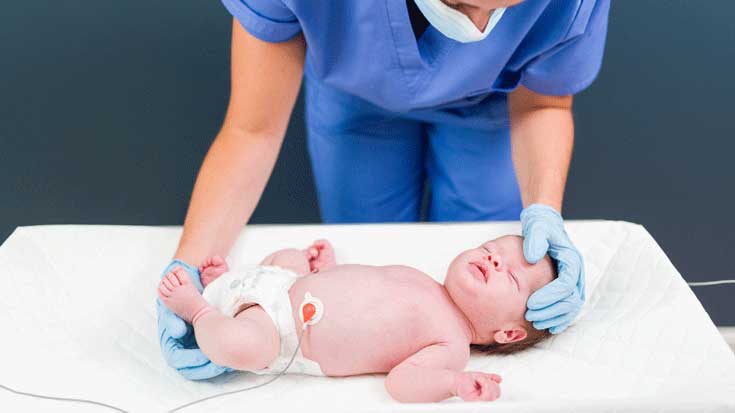
Telehealth has been talked about in medical circles for more than a decade now, and the AARC has advocated for greater use of RTs in this setting. But until the novel coronavirus upended everything in health care in early 2020, progress had been slow. As we enter 2021, telehealth isn’t just an idea worth considering, it’s a full-fledged service being provided across the country, and respiratory therapists are increasingly finding themselves part of the mix.
Visits go virtual at the VA
Jeff Chitty, RRT, is chief of respiratory care at the North Florida/South Georgia Veterans Health System headquartered in Gainesville, FL. He says telehealth has become the norm for many services offered by the VA since the onset of the pandemic.
“In efforts to reduce foot traffic within our facilities, we have moved all visits to virtual if at all possible,” he said.
In the sleep setting, that has meant converting to telehealth to screen patients before their sleep study to determine whether they can participate in a virtual visit going forward. Patients are mask-fitted during the sleep study visit itself and receive an explanation on how the process will work if they end up qualifying for a PAP device. If the patient qualifies, the device is mailed to the home and a virtual appointment is set up between the patient and RT to provide the necessary patient education on the device.
They have found this process works well, but Chitty emphasizes it isn’t for every patient.
“Our older population of patients has a hard time understanding the technology,” he said. “We service a lot of rural patients as well, which plays a big part, as some areas do not have great internet access.”
Still, he believes the pandemic has opened the door to greater use of telehealth for patients, especially those who would rather not sit in a waiting room among other patients.
“It saves time for the patient in driving and allows a convenience, as well for patients to connect in the evening and not have to miss a day of work,” Chitty said. “I see this telework only increasing in popularity in the future.”
Resuming interrupted care
COVID-19 has not only flooded the health care system with patients suffering from a deadly virus, but it has also interrupted care for many non-COVID patients who can’t afford to have their care interrupted as well. At Tampa General Hospital in Florida, telehealth is helping to ensure ongoing pulmonary rehabilitation for one such critical group: lung transplant patients before and after their transplants.
“During the lockdown, our program was closed like most throughout the nation,” said Jennifer Keane, RRT, AE-C, TTS, pulmonary rehabilitation coordinator at the facility. “Due to the fact that respiratory care services were approved for telehealth, we were able to qualify for and create a virtual pulmonary rehab program using the charge, Respiratory Therapeutic Services, which falls under pulmonary rehab within our state.”
Therapists in the program began reaching out to patients within a couple of months of the lockdown to offer them pulmonary rehab at home using software applications. Most of their patients already have smartphones or tablets, so they have found it easy to navigate the technology involved, and Keane says the virtual visits have alleviated some of the barriers to participation the program experienced in the past, such as lack of transportation and conflicting appointments and tests.
“Meeting virtually resolves these issues,” she said.
Because the virtual program is carried out on a one-on-one basis, therapists believe they can create a more intimate and customizable educational component for their patients as well.
“The patients love it, they feel safe, and we are creating a home exercise program for them that they can continue for life,” Keane said. “At home is a safe environment for our patients.”
Ready to go
Therapists at Integrated Respiratory Solutions in the Chicagoland area of Illinois were forced to do a 180 when COVID-19 hit, says Vrati Doshi, MS, RRT, respiratory programs director for the firm. While high acuity NIV and cough assist patients still receive in person set ups, all other respiratory and sleep equipment set ups have pivoted to virtual.
Luckily, they were prepared to make the move.
“Our internal platform has the functionality of video conferencing, which allowed us to ship the equipment and continue to provide equipment setup and education to patients,” she said. “All of our sleep patients are 100% virtual.”
RTs at the firm also partner with skilled nursing facilities to provide virtual nursing and physician rounding, something Doshi says has worked well for pulmonologists who have been hesitant to expose themselves to COVID-19 by going onsite.
“Through our virtual platform, our RT can continue conducting physicians rounds without the physicians physically being there,” she said.
Doshi believes the pandemic has forced therapists, physicians, and post-acute facilities out of their comfort zones. They’ve had to get creative and meet barriers head on, and in the process, they’ve demonstrated that telerespiratory works.
“Nothing beats an in-person assessment, but this pandemic has shown that a virtual assessment can provide adequate care and education,” she said. “With the need for chronic disease management and reduction of readmission rates and rising health care costs, telerespiratory is a much-needed solution that needs to be included in legislation.”
Looking forward faster
Chris Thebeau, RRT, is a telerespiratory therapist at rtNOW, a telehealth company based in Minnesota that grew out of an RT staffing firm. Founded to provide quick access to the expertise of an RT to clinicians in rural hospitals in Minnesota and surrounding states that may not have an RT on staff, the company was well suited to rise to the needs created by the pandemic.
“The pandemic has forced organizations to look forward faster than they may have before,” Thebeau said. “At rtNOW, the services we provide to the hospital allow them to keep higher acuity patients that they may have otherwise had to transfer. The cost savings of that alone is a valuable investment for them.”
He and his fellow RTs on the telerespiratory team provide equipment troubleshooting, respiratory assessments, guidance on the use of noninvasive ventilation, and what he calls “just-in-time” education for staff and patients.
“We also provide equipment troubleshooting to patients in the home for several DME companies,” he said.
One obstacle currently hampering greater use of RTs in the telehealth role, says Thebeau, is the need to acquire a license in every state where the service is provided.
“We’ll need to work on communicating with our state legislators about legislation to bring compact licensure across our country for respiratory therapists,” Thebeau said.
Formalizing the process
The pandemic has certainly accelerated the use of telehealth, but Ashley Tabbert, RRT, argues RTs have been delivering care remotely in some situations for years.
“Think about pre-pandemic for organizations with RT departments with one RT on duty at a time,” she said. “A neonatal patient was just resuscitated and is in the midst of stabilization while waiting for a transport team — no RT would leave that bedside, and nobody would reasonably ask them to.”
Instead, therapists in that position have fielded questions over the phone from other members of the health care team caring for other patients in the hospital who need the services of an RT, walking them through respiratory interventions ranging from setting up a continuous neb, to adjusting NIV settings, to troubleshooting alarms. They may not have called it “telehealth,” but that is what it was.
In her role as vice president of growth and director of tele pulmonary and tele respiratory therapy at Beam Healthcare, a firm providing facilities with telehealth solutions, Tabbert has been intimately involved in formalizing the process. Her facility currently supports the use of tele-RTs to review the electronic medical record, communicate with onsite teams, and coordinate care with the onsite and tele-pulmonary teams during pulmonary e-consults.
“The future of telehealth and RTs is promising,” Tabbert said. “Patient education, pulmonary rehab, smoking cessation, and partnering with home health are just a few examples that would make a huge impact on the lives of our patient communities.”
An extra layer of PPE
RTs at the Medical University of South Carolina (MUSC) in Charleston, have been involved in telehealth initiatives for some time now, including as part of the facility’s school-based telehealth program, where they provide asthma education and management to students, school nurses, and parents. The service is covered by both Blue Cross Blue Shield and Medicaid.
COVID-19 has boosted their role on the inpatient side as well.
“Because MUSC is telehealth enabled in every room, they are able to call into the rooms either of COVID or non-COVID patients who are on vents to assess the patient and provide feedback on ventilator settings and management without having to enter the room,” said Brooke McSwain, MSc, RRT, who previously worked with the MUSC Center for Telehealth. “This has served as a form of extra PPE in a sense.”
The services extend out to other hospitals in the state that are connected to the MUSC’s telehealth system as well and are covered as part of standard inpatient billing.
McSwain, who is now working in a health care policy and government relations role for a national telehealth collaborative headquartered at MUSC, believes the RT’s role in telehealth is going to grow further because of the pandemic. But many of the specifics will be parsed out on a state-by-state basis.
For example, she says in North Carolina, emergency legislation now allows RTs to see patients with chronic respiratory problems secondary to COVID-19 via telehealth visits in their homes, if they have remote monitoring equipment. While getting any kind of legislation passed these days is a challenge, she believes changes in state-by-state private insurance and Medicaid coverage policies are possible with the right advocacy.
“This will require data on cost savings, quality of care, and depending on which state legislature you’re advocating to, data on how it affected disparities in care,” she said. RT-specific data would be good to have, but it might not be a game ender if it isn’t available. If the evidence shows effective outcomes for telehealth visits made by MDs and APRNs, then the assumption could be made that those findings would apply to RTs too.
“An extrapolated argument can be made for allowing RTs to see these patients since the standard of care is the same . . . and RTs are reimbursed at lower rates than MDs and APRNs, which clearly would lead to cost savings,” McSwain said.
This is the future
Corner Home Medical in New Hope, MN, is another firm that already had telehealth experience under its belt when the pandemic began. For the past four years, they’ve been running a COPD telehealth program offering patient education, measurements, and video resources.
Director of Clinical Services Sean Denning, BS, RRT, says they connected their home ventilators to remote monitoring to ensure ongoing care during the pandemic. RTs use those remote monitoring platforms to assess their individual patients daily to determine where their needs lie.
As of this writing in late 2020, they were getting ready to launch a COVID telehealth program featuring many of the same components as the COPD program already in place.
“We see that telehealth is a key aspect to respiratory therapy,” Denning said. “This is the future to health care, and as RTs, we need to be involved and in the forefront.”
Proactive stance
The telehealth success seen in many areas of the country can be traced in part to the work done by the AARC to outline billing codes for RTs providing these services in the wake of COVID-19. The Minnesota Society for Respiratory Care (MSRC) has taken a proactive stance, says Carrie Bourassa, RRT, MSRC Legislative Committee co-chair.
“In March 2020, the MSRC developed an ad hoc committee on telehealth to address the need for increased patient access to respiratory therapists during the pandemic,” she said.
The goals of the committee were to gather telemedicine billing codes now available for use by respiratory therapists in Minnesota, provide these billing codes to respiratory therapists and organizations, act as a resource for understanding the use of the codes, and gather outcome data to support the continued use of these, or similar, codes going forward.
Bourassa, who is providing telehealth services in her facility in consultation with physicians in the ICU setting, says MSRC members have reported using these codes, and she believes the good press they have received for their integral role in managing COVID-19 patients in the ICU will help to foster their greater involvement in telehealth as well.
“The year 2020 has certainly provided recognition of the respiratory therapist as the experts in ventilator management,” she said. “With recognition, areas such as improved patient outcomes, reduction in readmissions, and considerable reduction in costs will foster long-term opportunity for RTs in telehealth.”
MSRC Telehealth Ad Hoc Committee member Sean Severson, MPH, RRT, who works as a clinical support specialist at HillRom, believes RTs are right for the job, if they realize it will take adaptation and innovation to meet patient needs.
“I have learned that this type of work requires additional skills and techniques that I did not fully develop in school, working in the hospital, or even the home care environment,” he said. “Troubleshooting complex medical equipment with patients who are in unique home environments, who often lack understanding of disease processes, requires a whole new level of communication skills for successful problem resolution.”
Here to stay
There is no question telehealth has gotten a big boost from the pandemic. Providers desperate to ensure people could still receive care during a shutdown jumped on board, and patients who would have never agreed to a virtual visit before suddenly found the prospect not only doable but essential to their safety. Everyone learned how to navigate the technology involved and many came to see how these kinds of visits could be here to stay.
Respiratory therapists are key providers for patients with respiratory conditions, and they have the expertise and background needed to provide both patient assessment and patient education. The telehealth experience they are getting now as the pandemic rages on is bound to serve them well in the post-COVID era to come.
For the latest news and information about AARC efforts to facilitate telehealth for respiratory therapists, read this Q&A featuring AARC Associate Executive Director of Government Affairs Anne Marie Hummel.
Email newsroom@aarc.org with questions or comments, we’d love to hear from you.














